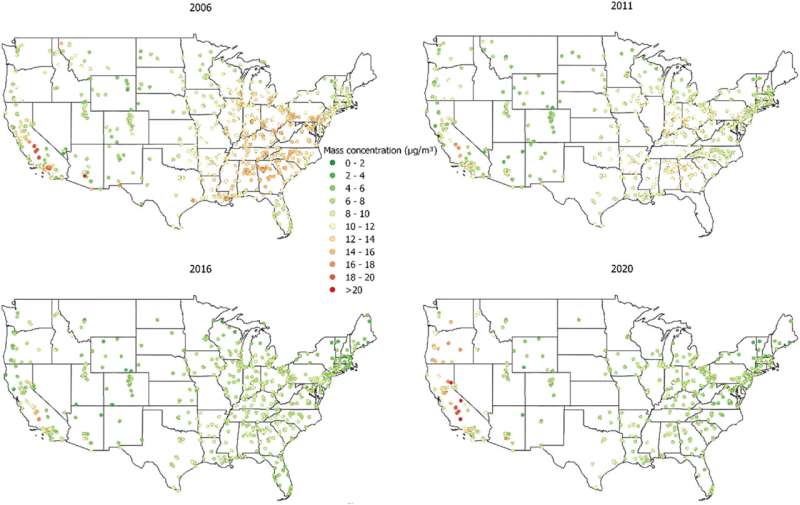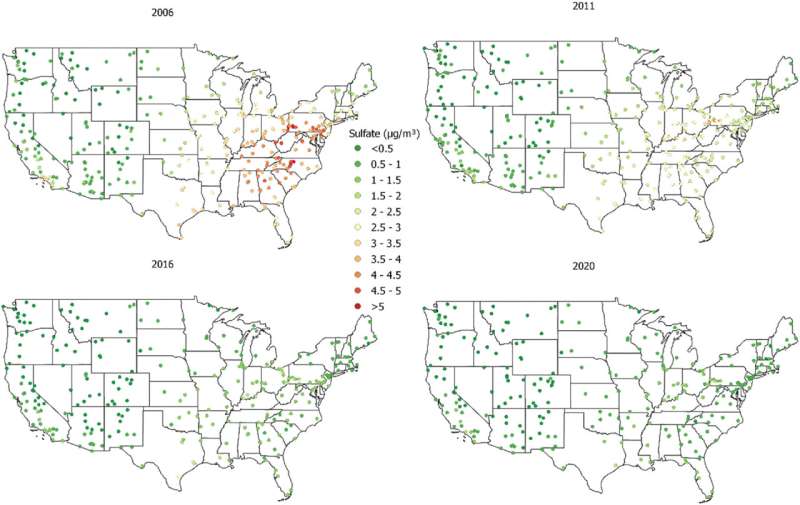This article has been reviewed according to Science X's editorial process and policies. Editors have highlighted the following attributes while ensuring the content's credibility:
fact-checked
trusted source
proofread
New study describes how chemical composition of US air pollution has changed over time

A new study published in Atmospheric Environment by researchers at the University of North Carolina at Chapel Hill has analyzed space and time trends for fine particulate matter (PM2.5) in the continental United States to track the progress of regulatory actions by federal, state and local authorities aimed at curbing air pollution.
The team found that while the annual average concentration for PM2.5 had been significantly reduced, its chemical composition had changed during the study period of 2006 to 2020. Their analysis suggests targeted strategies to reduce specific pollutants for different regions of the U.S. may be more effective in further reducing total air pollution and PM2.5-related adverse health effects.
PM2.5, an airborne pollutant, is a mix of multiple chemical species and includes fine particles less than 2.5 microns in size. PM2.5 has been linked to many adverse human health effects including premature death. It also can reduce visibility by creating haze in the air.
"The results from this study are especially timely given the EPA's revision of the health-based standard for PM2.5 from 12 µg/m3 to 9 µg/m3 that was just announced this month," said Saravanan Arunachalam, senior author of the study and deputy director of the UNC Institute for the Environment.
"States with monitors that are exceeding the new standard for PM2.5 will be looking to understand the chemical constituents of PM2.5, and how they have changed over time, and this will be key to developing emissions reductions policies to address potential future nonattainment designations."
Using data from the U.S. EPA Air Quality System (AQS), the research team assessed trends across the 48 contiguous U.S. states. Chemicals found in PM2.5 in the U.S. include sulfate, ammonium, nitrate, organic carbon, elemental carbon and other trace elements, which come from a variety of human-created and natural sources.
The biggest air quality improvements during this 15-year period that was analyzed were observed in areas with the worst baseline air quality. The Ohio Valley and southeastern states, for example, had the biggest improvements due to regulations on emissions sources such as coal-burning power plants and industry.
Sulfur dioxide emissions, a byproduct of fossil fuel combustion, decreased 91.5% from power plants during the study period. Most of the sulfur dioxide emissions in the study came from the Ohio Valley and the southeastern U.S. A spike in poor air quality along the West Coast in 2020 was likely due to widespread forest fires.

Although across the U.S. sulfate and ammonium levels have declined, the researchers suggest looking at mitigating other sources of carbon in the environment to further improve air quality, given the increasing contribution of carbon to total PM2.5. High pollution days have waned in recent years, but primary organic carbon peaked during winter months due to the reduced formation rate of secondary organic aerosols at low temperatures.
These regional differences, the researchers point out, show that regionally targeted approaches to air pollution mitigation will further improve the country's air quality and decrease health care expenses for air pollution-related health issues and further save human lives.
"Different chemical constituents of PM2.5 are linked to various emissions sources, thus, the development of future emissions control strategies to reduce PM2.5 concentrations should be based on the comprehensive analysis of spatiotemporal trends of PM2.5 chemical composition and deep understanding of the relationships between changes in emissions and ambient concentrations," said Bin Cheng, a co-author and research associate at the Institute.
"The results from this study will also contribute to future epidemiological studies to identify specific PM2.5 components that affect human health more than others," added Arunachalam.
More information: Bin Cheng et al, Spatiotemporal trends in PM2.5 chemical composition in the conterminous U.S. during 2006–2020, Atmospheric Environment (2023). DOI: 10.1016/j.atmosenv.2023.120188
Provided by University of North Carolina at Chapel Hill





















